Save Your Town co-founder taps into seven years of surveys with small communities
MANHATTAN, Kan. – More than half of the residents and community development officials responding to the most recent iteration of a survey of rural challenges have noted that a lack of good housing is one of the top challenges in their communities.
That’s the word from Becky McCray, who was the featured speaker Sept. 3 during K-State Research and Extension’s monthly online series, First Friday e-Calls, which helps to nurture small businesses and inspire entrepreneurship in Kansas.
“I can’t waive a magic wand to give you easy answers that will solve all your housing problems no matter where you are,” McCray told the online gathering of more than four dozen. “What I can do is help you apply the Idea Friendly Method to make your local project easier.”
McCray, who is the co-founder of Save Your Town, a consulting business that guides people toward making their small towns a better place to live, helped develop the Idea Friendly Method to help people in small towns with a plan to inspire positive change.
Her simple guidelines are applicable to many rural challenges – downtown development, retaining younger residents and more – but specific to housing, she said:
• Gather your crowd. “You can’t do much about housing all by yourself, so you want to attract people who also care about this issue.” McCray suggested such ideas as building a mock-up of a house to get people talking, borrow a modular home from a local builder and display it at a community event, or even build a cardboard home to use as a visual reminder.
“You want to spark conversation,” McCray said. “Let people know there’s a housing project going on by giving them something to see and talk about.”
• Build connections. People won’t automatically know how they can help, so ask a couple key questions to get them involved.
“Who do you know that knows more about this?”
“Do you have, or know where to find, a resource that we need more of?”
• Take small steps. Everything about rural housing may seem big, but there is room for smaller projects. “Get people to tour places around town,” McCray said. “Or, ask people to spot existing empty lots that you can fill with newer housing. Identify houses that need improvement or rehab so you can connect with those people who can do improvements.”
Since 2015, Save Your Town has conducted the biennial Survey of Rural Challenges asking rural residents about their greatest challenges for improving their communities. The 2021 report is now online and available for free download.
Through her experiences and talking with rural leaders across the country, McCray was able to share many ideas for tackling the challenge of housing in rural areas. Some of the ideas include making maps of all the houses in the community to assign ‘condition scores;’ rally local volunteers or programs to update homes for those unable to do so themselves; create a local investment team to fix rental houses; and add housing in current residential areas.
“Rather than stretching your town’s infrastructure (like water and sewer) out to meet new developments, add housing in existing residential areas to capitalize on the infrastructure you’ve already invested in,” McCray said. “This also keeps your town more compact, putting new housing closer to your downtown core and other essential services.”
And, she adds, it helps residents feel like they are part of the community: “People who live close to the core can walk and bike more to run errands. They can get out and join local community events more easily…and they can feel more connected to your community. So you can see that it’s important to fill those empty lots as much as you can.”
AARP publishes a helpful resource to help communities address housing issues. McCray said AARP Livable Communities, which include a HomeFit Guide, is available online for free.
McCray’s full talk and other First Friday presentations are available online from K-State Research and Extension.
-30-
FOR PRINT PUBLICATIONS: Links used in this story
Save Your Town, https://saveyour.town
Survey of Rural Challenges, https://learnto.saveyour.town/survey-rural-challenges-2021
AARP Livable Communities, https://www.aarp.org/livable-communities
K-State Research and Extension First Friday e-Calls, www.ksre.k-state.edu/community/business/entrepreneurship
K State Research and Extension is a short name for the Kansas State University Agricultural Experiment Station and Cooperative Extension Service, a program designed to generate and distribute useful knowledge for the well being of Kansans. Supported by county, state, federal and private funds, the program has county extension offices, experiment fields, area extension offices and regional research centers statewide. Its headquarters is on the K State campus in Manhattan. For more information, visit www.ksre.ksu.edu. K-State Research and Extension is an equal opportunity provider and employer.
Story by:
Pat Melgares
785-532-1160
melgares@ksu.edu



